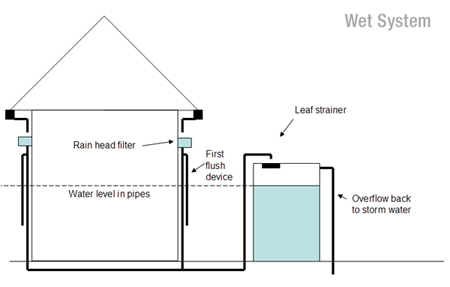 How To Install Your Water Tank
How To Install Your Water Tank
This brief guide will help to show you how to connect a water tank.
Generally, most water tank installations involve using PVC stormwater pipe to direct rainwater from the gutter to the inlet of the tank, as shown in the “Dry System” image above. The PCV pipe is quick and easy to connect, and is glued with a water tight cement. PVC is inexpensive and neat, and can be painted to match other downpipes or the wall of your home.
Other alternatives to PVC include using rolled metal downpipes, and high density polyethylene (HDPE) pipe.
 The simplest way to connect the downpipe to the top of the water tank is to run the pipe directly, allowing some fall in the pipe so the water flows by gravity to the water tank inlet. You can install a first flush water diverter and / or a rain head to help keep sediment and leaves out of the water tank. This is called a dry system, as the pipes are allowed to dry out once the rain has stopped.
The simplest way to connect the downpipe to the top of the water tank is to run the pipe directly, allowing some fall in the pipe so the water flows by gravity to the water tank inlet. You can install a first flush water diverter and / or a rain head to help keep sediment and leaves out of the water tank. This is called a dry system, as the pipes are allowed to dry out once the rain has stopped.
An alternative system connects one or more downpipes underground and runs the water in an underground pipe to the tank location, as shown in the “Wet System” image. This system relies on hydraulic head pressure to force the water through the sealed pipes and up into the water tank inlet. This is termed a wet system, as the water stays in the pipes after the rain has stopped.
Using a wet system allows you to capture water from a larger roof area, as the rainwater tank does not need to be near each downpipe. It is important to consider the height differential between the bottom of the gutter and the top of the water tank, and allow at least 500mm differential. Contact us for more information on designing wet systems.
When installing a wet system, it is important to consider filtering the water before it enters the underground stormwater pipes. This is usually done with a first flush and / or rain head installed under the gutter. Inspection points should also be installed in the system to allow it to be flushed out if required. Gutter guard may also be effective at keeping your wet system flowing freely.
Down-Pipe Location
For best results the down-pipes to be diverted to the water tank should be no more than five (5) metres from the tank site. The ideal fall should be approximately 300mm from the top of the inlet pipe to the top of the tank. Ideally you want to position a water tank as close as possible to the house to avoid overhead pipes. Overhead pipes need to be supported every 2m so they don’t bow when full of water.
Overflow
All installations need to give some consideration to the water tank overflowing. In fact most councils insist the overflow be piped back to the existing stormwater or a rubble pit.
Ideally the overflow will be piped back to the existing stormwater system. If there is no existing stormwater system, or the size or position of the water tank precludes the overflow returning to the stormwater, a rubble pit may be required. A rubble pit is a cubic metre excavated from the ground and filled with drainage gravel. The overflow pipe will be directed to the rubble pit.
If you require assistance installing your water tank, in the greater Brisbane area, please contact Gardeners Watertanks on 1300 556 813, or use our contact form.
